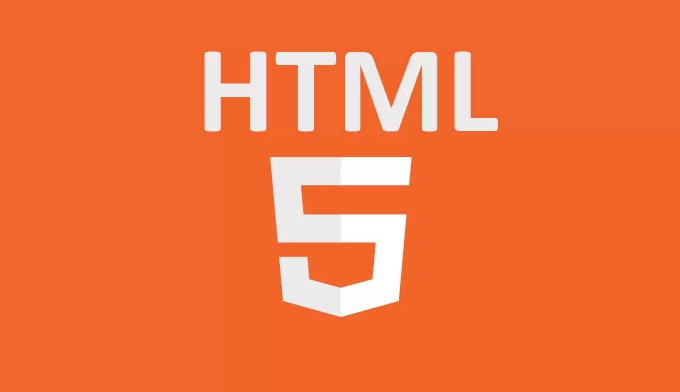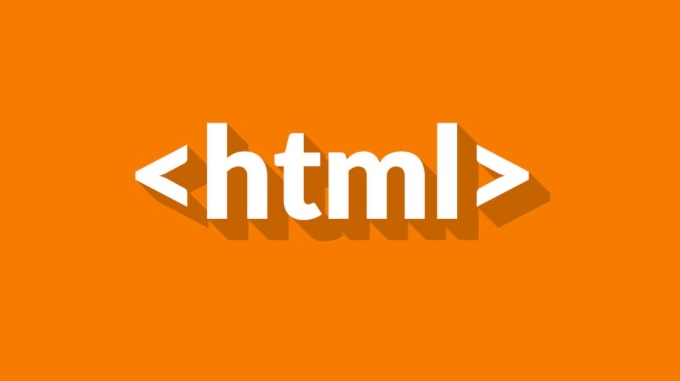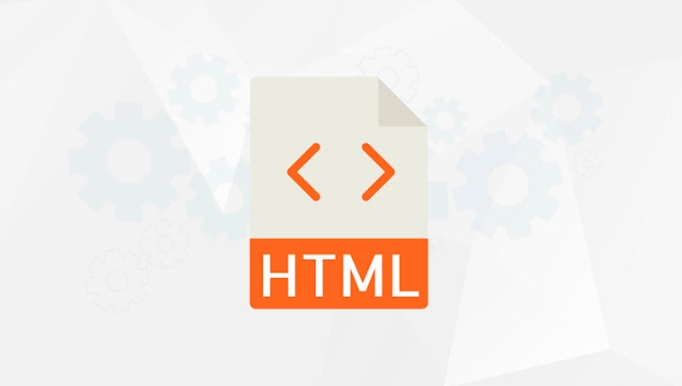<template> is a lazy container in HTML for storing unreleased content. The browser does not parse its internal structure or load resources until it is explicitly inserted into the DOM through JavaScript. Its advantages include better performance, safer, and clearer semantics. The steps are: 1. Define the template content; 2. Get the template content (via .content); 3. Insert the page using document.importNode(); it is also widely used in modern frameworks such as Vue and is compatible with mainstream browsers.

The HTML <template></template> tag you may have heard of, or you may have seen it occasionally in projects, but most people don't know much about it. In fact, it is a very practical tag, especially when you need to reuse HTML fragments, it can help us save a lot of trouble in DOM operations.

Simply put, <template></template> is a container used to store "unrendered content". The browser will not parse the structure inside, nor will it trigger resource loading or script execution until you manually insert it into the page. This is especially useful in building dynamic content, component development, or front-end templates.
What is the <template></template> tag?
The <template></template> tag is essentially a lazy container . You can put any HTML content in it, but it is "invisible" by default. That is, even if you write <script></script> or <img src="/static/imghw/default1.png" data-src="https://img.php.cn/upload/article/000/000/000/175382071586312.jpeg" class="lazy" alt="Deep Dive into HTML `template` Tag" > in it, they won't be executed or loaded immediately.

for example:
<template id="myTemplate"> <div class="box">This is a template content</div> </template>
The above code will not be displayed on the page unless you take it out through JavaScript and insert it into the DOM.

Why use <template> instead of writing hidden elements directly?
Many people will ask: Why not just use display: none 's <div> to save template content? It looks like the same effect.
Actually, there are several key differences:
- Better performance : The content in
<template>will not be parsed and rendered by the browser, so style calculation, layout reordering and other operations will not be triggered. - Safer : The scripts inside will not run automatically, and the images will not load, avoiding unnecessary side effects.
- Semantic clarity : It explicitly means "this is a template", which is more readable and maintained than a hidden div.
For example, if you have a form item that needs to be generated multiple times, it would be more appropriate to put it in <template> .
How to use <template> ?
Using <template> is mainly divided into three steps:
- Define the template content;
- Get template content;
- Insert into the page.
Let’s take a look at a simple example:
<template id="userCard">
<div class="card">
<h3>Username: John</h3>
<p>Email: john@example.com</p>
</div>
</template>
<script>
const template = document.getElementById('userCard');
const clone = document.importNode(template.content, true);
document.body.appendChild(clone);
</script> This way, the template content is inserted into the page. Note that document.importNode() is used here, and the second parameter true represents a deep copy, otherwise only the first layer of node will be copied.
<template></template> Application in modern frameworks
Although <template></template> is a feature provided by native HTML, it can also be seen in modern frameworks such as Vue and React.
For example, in Vue, <template></template> in the .vue file is the structural part of the component. Although it will eventually be compiled into a render function, it is conceptually consistent with the native <template></template> .
You can even implement a simple <template></template> system in your own small project, such as:
- Define multiple
<template></template>blocks as different components; - Dynamically replace data through JS (can be replaced with placeholder regular);
- Insert into the page as needed.
Although this approach is not as powerful as the framework, it is very helpful for lightweight projects or learning purposes.
What should I pay attention to when using <template></template> ?
- Cannot access child nodes directly : document fragments must be obtained through the
.contentattribute; - Form submission is not supported : because the template content is not in the active document stream;
- Good compatibility : mainstream modern browsers support it, including Chrome, Firefox, Edge, and Safari;
If you want to be compatible with old browsers (such as IE), you have to consider a fallback solution or polyfill.
Basically that's it. <template></template> is not a complicated thing, but its existence makes front-end template processing more natural and efficient. It is actually a pity that many developers ignore it. Next time you encounter the need to repeatedly generate similar structures, you might as well give it a try.
The above is the detailed content of Deep Dive into HTML `template` Tag. For more information, please follow other related articles on the PHP Chinese website!

Hot AI Tools

Undress AI Tool
Undress images for free

Undresser.AI Undress
AI-powered app for creating realistic nude photos

AI Clothes Remover
Online AI tool for removing clothes from photos.

Clothoff.io
AI clothes remover

Video Face Swap
Swap faces in any video effortlessly with our completely free AI face swap tool!

Hot Article

Hot Tools

Notepad++7.3.1
Easy-to-use and free code editor

SublimeText3 Chinese version
Chinese version, very easy to use

Zend Studio 13.0.1
Powerful PHP integrated development environment

Dreamweaver CS6
Visual web development tools

SublimeText3 Mac version
God-level code editing software (SublimeText3)

Hot Topics
 Applying Semantic Structure with article, section, and aside in HTML
Jul 05, 2025 am 02:03 AM
Applying Semantic Structure with article, section, and aside in HTML
Jul 05, 2025 am 02:03 AM
The rational use of semantic tags in HTML can improve page structure clarity, accessibility and SEO effects. 1. Used for independent content blocks, such as blog posts or comments, it must be self-contained; 2. Used for classification related content, usually including titles, and is suitable for different modules of the page; 3. Used for auxiliary information related to the main content but not core, such as sidebar recommendations or author profiles. In actual development, labels should be combined and other, avoid excessive nesting, keep the structure simple, and verify the rationality of the structure through developer tools.
 What are the essential HTML elements for structuring a webpage?
Jul 03, 2025 am 02:34 AM
What are the essential HTML elements for structuring a webpage?
Jul 03, 2025 am 02:34 AM
The web page structure needs to be supported by core HTML elements. 1. The overall structure of the page is composed of , , which is the root element, which stores meta information and displays the content; 2. The content organization relies on title (-), paragraph () and block tags (such as ,) to improve organizational structure and SEO; 3. Navigation is implemented through and implemented, commonly used organizations are linked and supplemented with aria-current attribute to enhance accessibility; 4. Form interaction involves , , and , to ensure the complete user input and submission functions. Proper use of these elements can improve page clarity, maintenance and search engine optimization.
 Implementing client-side form validation using HTML attributes.
Jul 03, 2025 am 02:31 AM
Implementing client-side form validation using HTML attributes.
Jul 03, 2025 am 02:31 AM
Client-sideformvalidationcanbedonewithoutJavaScriptbyusingHTMLattributes.1)Userequiredtoenforcemandatoryfields.2)ValidateemailsandURLswithtypeattributeslikeemailorurl,orusepatternwithregexforcustomformats.3)Limitvaluesusingmin,max,minlength,andmaxlen
 What are self-closing tags in HTML?
Jul 02, 2025 pm 02:55 PM
What are self-closing tags in HTML?
Jul 02, 2025 pm 02:55 PM
Self-closing tags are elements in HTML that do not require closed tags because they do not contain content. Common examples include: ① Insert pictures; ② Add line breaks; ③ Create horizontal lines; ④ Define form input; ⑤ Link external resources; ⑥ Provide metadata. These tags work through attributes such as or. There are two correct ways to write: standard HTML syntax, such as XHTML style, but HTML5 recommends the former. Note that you cannot use self-closed form on labels that require the package content. If the error is wrong, it should be changed to a correctly closed Hello. Proper use of self-closing tags helps keep your code simple and efficient, and improves compatibility with other tools such as frameworks.
 Implementing Clickable Buttons Using the HTML button Element
Jul 07, 2025 am 02:31 AM
Implementing Clickable Buttons Using the HTML button Element
Jul 07, 2025 am 02:31 AM
To use HTML button elements to achieve clickable buttons, you must first master its basic usage and common precautions. 1. Create buttons with tags and define behaviors through type attributes (such as button, submit, reset), which is submitted by default; 2. Add interactive functions through JavaScript, which can be written inline or bind event listeners through ID to improve maintenance; 3. Use CSS to customize styles, including background color, border, rounded corners and hover/active status effects to enhance user experience; 4. Pay attention to common problems: make sure that the disabled attribute is not enabled, JS events are correctly bound, layout occlusion, and use the help of developer tools to troubleshoot exceptions. Master this
 How to group options within a select dropdown using html?
Jul 04, 2025 am 03:16 AM
How to group options within a select dropdown using html?
Jul 04, 2025 am 03:16 AM
Use tags in HTML to group options in the drop-down menu. The specific method is to wrap a group of elements and define the group name through the label attribute, such as: 1. Contains options such as apples, bananas, oranges, etc.; 2. Contains options such as carrots, broccoli, etc.; 3. Each is an independent group, and the options within the group are automatically indented. Notes include: ① No nesting is supported; ② The entire group can be disabled through the disabled attribute; ③ The style is restricted and needs to be beautified in combination with CSS or third-party libraries; plug-ins such as Select2 can be used to enhance functions.
 Configuring Document Metadata Within the HTML head Element
Jul 09, 2025 am 02:30 AM
Configuring Document Metadata Within the HTML head Element
Jul 09, 2025 am 02:30 AM
Metadata in HTMLhead is crucial for SEO, social sharing, and browser behavior. 1. Set the page title and description, use and keep it concise and unique; 2. Add OpenGraph and Twitter card information to optimize social sharing effects, pay attention to the image size and use debugging tools to test; 3. Define the character set and viewport settings to ensure multi-language support is adapted to the mobile terminal; 4. Optional tags such as author copyright, robots control and canonical prevent duplicate content should also be configured reasonably.
 Adding captions and tracks to HTML video and audio elements.
Jul 02, 2025 pm 04:05 PM
Adding captions and tracks to HTML video and audio elements.
Jul 02, 2025 pm 04:05 PM
To embed video or audio with subtitles and audio tracks into a web page, it can be achieved through HTML native functionality. 1. Use tags to add subtitles files in WebVTT format and set the kind, srclang and label attributes; 2. Support multi-language subtitles through multiple elements, and use the default attribute to set the default language; 3. Multi-tracks can control multiple element switching through JavaScript, or use more complex media extension solutions; 4. Pay attention to browser compatibility, path configuration and format verification to ensure normal operation on different devices and provide backup solutions.






